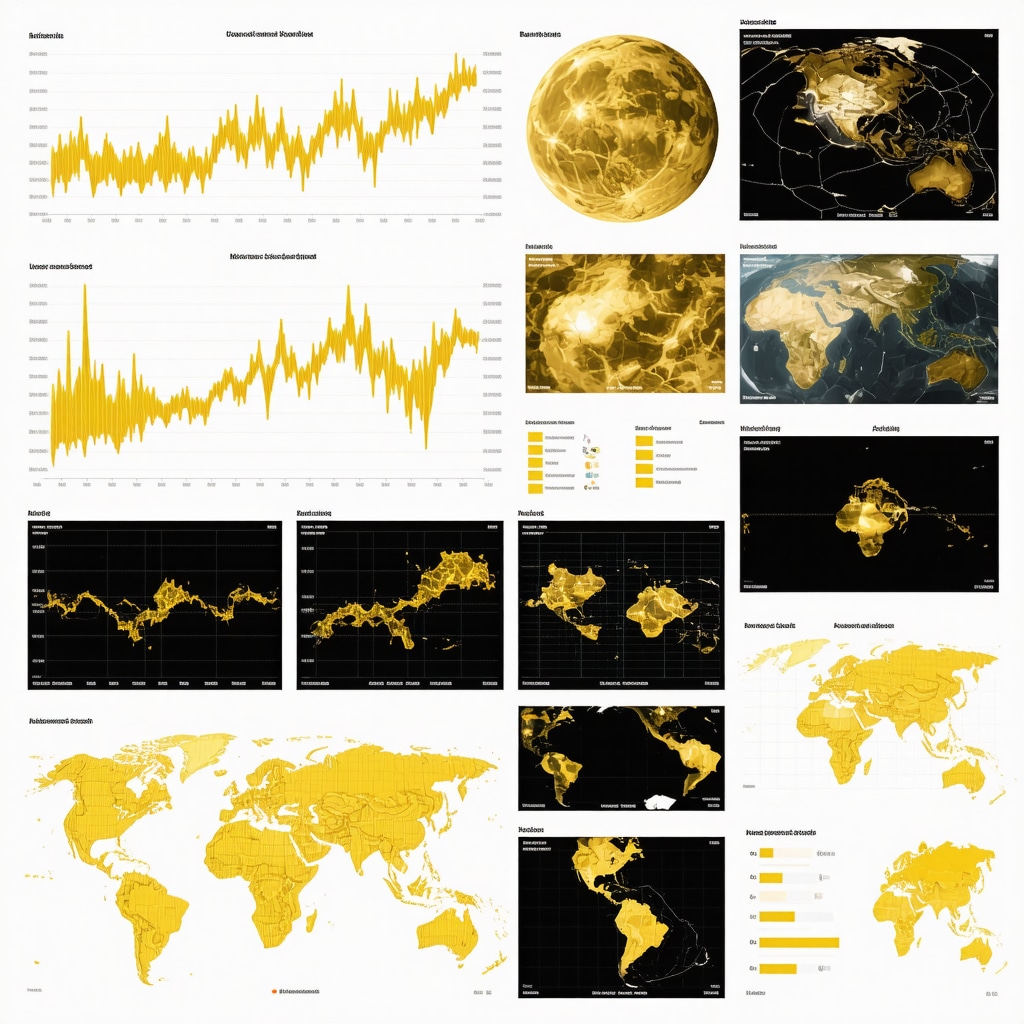Unveiling the Complex Drivers of Gold Prices in 2025: An Expert Perspective
As we navigate through 2025, understanding the intricate web of economic and political factors that influence gold prices becomes paramount for investors, policymakers, and industry stakeholders alike. Gold, long regarded as a quintessential safe haven asset, responds dynamically to macroeconomic shifts and geopolitical developments, necessitating a nuanced analysis rooted in expert insights.
The Impact of Macroeconomic Dynamics on Gold Valuations
One of the foremost drivers of gold prices in 2025 is the evolving macroeconomic landscape. Persistent inflationary pressures, driven by expansive monetary policies and supply chain disruptions, continue to elevate gold’s appeal as an inflation hedge. According to recent white papers, the interplay between inflation rates and real interest rates critically shapes gold’s attractiveness. When real yields decline, gold’s opportunity cost diminishes, prompting increased demand.
Monetary Policy Trajectories and Their Consequences
The monetary policy stance of major central banks, notably the Federal Reserve, European Central Bank, and the Bank of Japan, remains a pivotal factor. In 2025, a careful balancing act between tightening measures and accommodative policies influences liquidity and investor sentiment. A shift towards dovish policies may stimulate gold investments, while hawkish stances could exert downward pressure, especially if inflation is perceived to be under control.
Geopolitical Tensions and Political Instability as Catalysts
Geopolitical tensions, including ongoing conflicts and diplomatic frictions, fuel uncertainties that typically buoy gold prices. Political instability within key economies, such as elections or policy shifts, can also trigger risk aversion. For instance, the renewed focus on central bank gold purchases signals a strategic accumulation that may limit supply and elevate prices.
Supply Chain Disruptions and Mining Output Constraints
Beyond demand-side factors, supply constraints significantly influence gold prices. Mining output disruptions, environmental regulations, and geopolitical restrictions on resource extraction can tighten supply, creating upward price pressures. Analyzing demand trends in industry sectors reveals how supply-demand imbalances shape the market.
What Are the Most Effective Strategies to Hedge Against Volatility in 2025?
Expert investors are advised to diversify portfolios through physical gold, gold ETFs, and mining stocks, leveraging smart investment strategies. Incorporating technical analysis and market timing techniques can also optimize returns amidst fluctuating prices.
To deepen your understanding of gold’s future, explore our comprehensive market trend analysis in 2025. For those interested in strategic asset allocation, consider expert insights on gold mining stocks and shares.
Deciphering the Nuanced Dynamics Behind Gold Price Fluctuations in 2025
As investors seek to optimize their portfolios amidst volatile markets, understanding the subtle yet powerful factors influencing gold prices in 2025 becomes crucial. Beyond macroeconomic indicators, geopolitical shifts, and supply chain complexities, there are emerging trends and analytical frameworks that can provide a competitive edge. Experts are increasingly turning to sophisticated models that incorporate behavioral economics, sentiment analysis, and machine learning techniques to forecast gold’s trajectory more accurately.
Is Behavioral Economics Reshaping Gold Investment Strategies?
Traditional models often emphasize supply-demand fundamentals and macroeconomic data. However, recent research suggests that investor psychology and market sentiment play a pivotal role in short-term price movements. For instance, fear-driven buying during geopolitical tensions or herd behavior in response to central bank announcements can cause deviations from fundamental values. Incorporating sentiment analysis from social media, news outlets, and financial forums—using advanced AI tools—can help investors anticipate these transient yet impactful shifts.
According to a report by Harvard Business Review, integrating behavioral insights with quantitative models enhances predictive accuracy, especially in turbulent periods (Harvard Business Review).
The Role of Machine Learning in Gold Price Forecasting
Machine learning algorithms, such as neural networks and ensemble models, are increasingly employed to analyze vast datasets encompassing economic indicators, geopolitical events, commodity prices, and social sentiment. These models identify complex, non-linear relationships often missed by conventional analysis. For example, predictive models trained on historical data can flag potential price swings triggered by policy announcements or supply disruptions, giving investors a strategic advantage.
Implementing these tools requires access to quality data and expertise in AI, but the payoff can be significant—especially when combined with traditional fundamental analysis. For a practical approach, consider exploring advanced gold trading techniques that leverage data-driven predictions.
What Are the Most Promising New Frontiers in Gold Market Analysis for 2025?
Innovative analysis methods, including real-time satellite monitoring of mining activities and blockchain-based supply chain transparency, are beginning to influence market perceptions and pricing models. These technologies can shed light on actual supply constraints or uncover hidden reserves, informing smarter investment decisions.
To stay ahead, savvy investors should continuously expand their knowledge base. Consider exploring our detailed guides on gold demand trends and best gold coins and bullion options for wealth preservation.
Engagement with these cutting-edge analytical strategies can significantly enhance your ability to navigate the complex landscape of gold investment in 2025. Share your insights or questions in the comments below—your perspective could help fellow investors refine their strategies and capitalize on emerging opportunities in the gold market!
Harnessing Behavioral Economics and Data-Driven Models to Predict Gold Price Movements in 2025
As the financial landscape becomes increasingly complex, investors must leverage cutting-edge analytical tools that incorporate not only traditional economic indicators but also behavioral and sentiment analyses. The integration of behavioral economics into gold market forecasting recognizes that investor psychology often drives short-term price volatility, especially during geopolitical crises or macroeconomic shocks. For instance, during periods of heightened uncertainty, fear-driven buying can inflate gold prices beyond what fundamentals would suggest, creating potential mispricings that savvy investors can exploit.
Recent studies underscore the importance of sentiment analysis, which evaluates social media trends, news sentiment, and market chatter to gauge investor mood. Combining this with machine learning models trained on historical data enables the construction of predictive algorithms capable of identifying transient price anomalies. According to a comprehensive report by the Harvard Business Review, such hybrid models outperform traditional models by capturing non-linear relationships and psychological factors influencing the market.
Leveraging Machine Learning for Precision in Gold Market Predictions
Machine learning (ML) techniques, including deep neural networks, support vector machines, and ensemble methods, are transforming how we analyze gold price dynamics. These models process vast datasets encompassing macroeconomic variables, geopolitical event timelines, mining output reports, and social sentiment scores. Their ability to recognize complex patterns and non-linear relationships allows for more accurate short-term and medium-term forecasts.
For example, neural networks trained on historical gold prices alongside real-time geopolitical risk indices can provide traders with early signals of impending price swings. Moreover, integrating geospatial data—such as satellite imagery of mining regions—can enhance supply-side analysis, revealing potential disruptions or new resource discoveries. While deploying such sophisticated models requires expertise and robust data infrastructure, the potential benefits—such as improved timing for trades and risk mitigation—are substantial.
What Are the Challenges in Implementing AI-Driven Forecasting in Gold Markets?
Despite the promising capabilities of AI and machine learning, challenges remain. Data quality and bias can significantly impact model accuracy. Additionally, financial markets are influenced by unpredictable black swan events that even the most advanced models may not anticipate. Therefore, combining AI insights with human judgment and traditional analysis remains essential for effective decision-making.
To deepen your expertise, explore resources like the AI in Financial Markets whitepapers or enroll in specialized courses on quantitative finance and machine learning applications in commodities trading. Embracing these technologies can provide a strategic edge in navigating the unpredictable terrain of gold investments in 2025.

Unraveling the Multifaceted Influences on Gold in 2025: An Expert Deep Dive
As the financial landscape evolves, sophisticated investors seek to understand the nuanced catalysts shaping gold’s trajectory in 2025. Beyond macroeconomic fundamentals, emerging analytical tools and geopolitical nuances are increasingly pivotal in crafting predictive models with high precision.
The Intersection of Geopolitical Risk and Market Sentiment: A New Analytical Frontier
Geopolitical developments, including regional conflicts and diplomatic tensions, continue to exert significant influence on gold prices. However, the integration of sentiment analysis—leveraging AI-driven assessments of news flow, social media chatter, and political discourse—provides a granular understanding of market mood shifts. This fusion of geopolitical intelligence with behavioral economics enhances short-term forecasting accuracy, enabling investors to anticipate price surges driven by collective fear or optimism.

How Can Advanced Quantitative Models Revolutionize Gold Investment Strategies?
The deployment of machine learning algorithms, such as reinforcement learning and deep neural networks, allows for the assimilation of vast datasets—ranging from macroeconomic indicators to real-time satellite imagery of mining regions. These models uncover non-linear relationships and detect early warning signals of supply disruptions or demand spikes. According to a study by the MIT Sloan School of Management, integrating AI-driven predictive analytics significantly outperforms traditional econometric models in volatile commodity markets.
What Are the Ethical and Practical Challenges in AI-Enhanced Gold Market Forecasting?
Despite the promising potential of AI and machine learning, challenges include data bias, model overfitting, and the unpredictable nature of black swan events. Ethical considerations also arise around transparency and reliance on opaque algorithms. To address these issues, experts recommend hybrid approaches combining AI insights with human judgment and fundamental analysis, fostering more resilient investment frameworks.
To further refine your strategic approach, explore resources like the CFA Institute’s publications on quantitative analysis, and consider engaging with specialized AI in finance courses offered by leading universities. Embracing these innovations can empower you to navigate the complex, rapidly shifting terrain of gold investment in 2025 with greater confidence.
Expert Insights & Advanced Considerations
1. Incorporate Behavioral Economics for Short-Term Predictions
Understanding investor psychology and market sentiment is crucial. Behavioral economics models help anticipate transient price swings caused by geopolitical fears or herd behavior, providing a strategic edge in volatile markets.
2. Leverage Machine Learning for Precise Forecasting
Advanced AI models analyze vast datasets—including geopolitical events and social sentiment—to identify complex, non-linear relationships influencing gold prices. This technology enhances short- and medium-term prediction accuracy, supporting smarter investment decisions.
3. Monitor Supply Chain Transparency Technologies
Emerging tools like satellite monitoring and blockchain transparency are revolutionizing supply analysis, revealing actual supply constraints or hidden reserves that impact market dynamics and pricing models.
4. Integrate Multidimensional Data Sources
Combining traditional macroeconomic indicators with innovative data streams—such as real-time satellite imagery and social media sentiment—can uncover early signals of market shifts, reinforcing an investor’s strategic positioning.
5. Prepare for Ethical and Practical Challenges in AI Use
While AI-driven forecasting offers significant advantages, challenges include data bias, model overfitting, and black swan event unpredictability. Effective strategies involve hybrid models that combine AI insights with human judgment and fundamental analysis.
Curated Expert Resources
- Harvard Business Review: Offers comprehensive insights into behavioral finance and market sentiment analysis, vital for understanding short-term gold price movements.
- MIT Sloan Management Review: Provides cutting-edge research on AI and machine learning applications in commodity markets, including predictive analytics for gold.
- Financial Modeling Prep: Whitepapers and courses on AI in finance, equipping investors with practical knowledge to implement advanced forecasting models.
- CFA Institute Publications: Deep dives into quantitative analysis and ethical considerations when deploying AI tools for investment strategies.
- Blockchain and Satellite Data Reports: Industry reports on emerging technologies improving supply chain transparency and supply-demand analysis.
Final Expert Perspective
In the evolving landscape of gold investment, integrating behavioral economics, machine learning, and innovative supply analysis offers unparalleled strategic advantages. As 2025 unfolds, savvy investors will harness these advanced insights to navigate market volatility effectively. Embracing these technologies and methodologies is not just a competitive edge but a necessary evolution in expert-level gold market analysis. Engage with these resources, refine your analytical frameworks, and consider sharing your insights to contribute to a more informed investor community.










